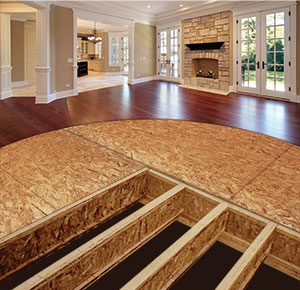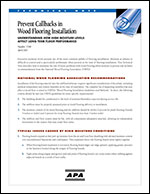 Excessive moisture levels present one of the most common pitfalls of flooring installation. Moisture at jobsites is difficult to control and is particularly problematic for long term floor performance when present at the time of installation. Here's 7 tips to minimize the risk of future problems with wood flooring when moisture is present.
Excessive moisture levels present one of the most common pitfalls of flooring installation. Moisture at jobsites is difficult to control and is particularly problematic for long term floor performance when present at the time of installation. Here's 7 tips to minimize the risk of future problems with wood flooring when moisture is present.
7 Practices that Minimize the Risk of Wood Flooring Installation Callbacks
1. Have a vapor barrier membrane in place on the crawlspace ground and ventilate/condition the crawlspace or basement prior to wood floor installation.
2. Consider methods to remove excessive moisture from the framing/floor sheathing and the rest of the interior of the building prior to installing the flooring, such as using an auxiliary dehumidifier.
3. Follow the recommended fastener schedule or consider augmenting the attachment by spacing the fasteners at closer intervals. For example, if the recommendations for fastening are 8 to 10 inches apart, keep fasteners no further than 8 inches apart. Ensure that the fastener size and spacing does not split the tongues of the flooring.
4. Make sure that the length and diameter of the flooring fasteners meets or exceeds flooring industry or the manufacturer’s recommendations. Flooring manufacturers typically recommend a minimum length of fastener. The greater the length of the fasteners’ embedment in the wood subfloor or the larger the shank diameter of the fasteners, the greater the fastener withdrawal capacity.
5. The recommendation for fastening of flooring boards is often within 1 to 3 inches of end joints. Keeping fasteners within 1 to 2 inches of end joints will better stabilize movement.
6. Consider using an approved flooring adhesive in conjunction with the recommended fastener schedule for flooring being installed with a liquid vapor-retarding system to control moisture migration.
7. In some situations, it may be necessary to build in expansion rows within the flooring system. This may include built-in gaps within the floor, t-molding transitions, cork, or other methods.
 Prevent Callbacks in Wood Flooring Installation
Prevent Callbacks in Wood Flooring Installation
For more detailed information, including recommendations from the National Wood Flooring Association (NWFA), typical issues caused with high moisture conditions, and complete recommendations for minimizing the risk of callbacks in wood flooring installation, download Technical Note: Prevent Callbacks in Wood Flooring Installation, Form T350.